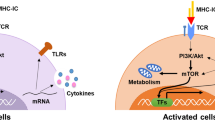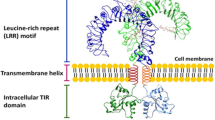Abstract
Pathogens can find their ways to most sites in the host. Pathogen sensors, such as Toll-like receptors (TLRs), must be equally and broadly distributed on immune cells to combat them through innate and adaptive immunity. Most classes of TLRs are found in innate immune cells to obtain an immediate response against pathogens, but recent studies indicate that a number of TLRs are wildly expressed in T and B cells, suggesting TLRs also directly regulate adaptive immune responses. Due to the rapid increase of new information on the multiple roles of TLRs, in this paper we aim to review several main properties of TLRs and their direct role in T and B cells. This review consists of 6 parts: (i) Characteristics of Toll-like receptors (TLRs) and signaling; (ii) signalling pathways of TLRs; (iii) TLR expressions on human leukocytes; (iv) TLR expressions and functions in the Th1, CD4+CD45RO+ memory T cells and regulatory/suppressor T as well as B cell populations; (v) therapeutic potential of TLR agonists; (Vi) discussion and perspective. The latest findings and potential therapeutic applications are discussed. There is growing evidence supporting the concept that TLR activation contributes not only to innate immunity but also to adaptive immunity, including direct regulation of both T and B lymphocytes by TLRs.
Similar content being viewed by others
References
Hoebe K, Beutler B. TLRs as bacterial sensors. In: O’Neill L A, Brint E, eds. Toll-like Receptors in Inflammation. Base Boston, Berlin: Birkäuser Verlag, 2006. 1–17
Beutler B. Inferences, questions and possibilities in Toll-like receptor signaling. Nature, 2004, 430: 257–263
Belvin M P, Anderson K V. A conserved signaling pathway: The Drosophila Toll-dorsal pathway. Annu Rev Cell Dev Biol, 1996, 12: 3343–3416
Lemaitre B E, Nicolas L, Michaut J M, et al. The dorsoventral regulatory gene cassette spatzle/Toll/cactus controls the potent antifungal response in Drosophila adults. Cell, 1996, 86: 973–983
Poltorak A, He X L, Simirnova I, et al. Defective LPS signaling in C3H/HeJ and C57BL/10ScCr mice: Mutationos in Tlr4 gene. Science, 1998, 282: 2085–2088
Zarember K A, Godowski P J. Tissue expression of human Toll-like receptors and differential of Toll-like receptor mRNAs in leukocytes in response to microbes, their products, cytokines. J Immunol, 2002, 168: 554–561
McGettrick A F, O’Neill L A. Toll-like receptors: key activators of leukocytes and regulator of haematopoiesis. Brit J Haematology, 2007, 139: 185–193
Ligoxygakis P, Bulet P, Reichhart J M. Critical evaluation of the role of the toll-like receptor 18-wheeler in the host defense of Drosophila. EMBO Rep, 2002, 3: 666–673
Uematsu S, Akira S. Toll-like receptors and type I interferons. J Biol Chem, 2007, 282: 15319–15323
Akira S. Mammalian Toll-like receptors. Curr, Opin, Immun, 2003, 15: 5–11
Hayden M S, Ghosh S. NF-kB in the innate immune system. In: Ghosh S, ed. Hand Book of Transcription Factor NF-kappa B. London: CRC Press, Taylor & Francis Group, 2007. 107–129
Shi Y, White D, He L, et al. Toll-like receptor tolerizes malignant B cells and enchances killing by cytotoxic agents. Cancer Res, 2007, 67: 1823–1831
Wang J, Shao Y, Bennett T A, Shankar R A, et al. The functional effects of physical interactions among Toll-like receptors 7, 8, 9. J Biol Chem, 2006, 281: 37427–37434
Gururajan M, Jacob J, Pulendran B. Toll-like receptor expression and responsiveness of distinct murine splenic and mucosal B-cell subsets. PLoS ONE, 2007, 2: e863
Babu S, Blauvelt C P, Kumaraswami V, et al. Diminished T cell TLR expression and function modulated the immune response in human filarial infection. J Immunol, 2006, 176: 3885–3889
Weaver C T, Hatton R D, Mangan P R, et al. IL-17 family cytokines and the expanding diversity of effector T cell lineages. Annu Rev Immunol, 2007, 25: 821–852
Wei L, Laurance A, Elias K M, et al. IL-21 is produced by Th17 cells and drives IL-17 production in a STAT-dependent manner. J Biol Chem, 2007, 282: 34605–34610
Imanishi T, Hara H, Susuki S, et al. TLR2 directly triggeres Th1 effector functions. J Immunol, 2007, 178: 6715–6719
Peng G, Guo Z, Kiniwa Y, et al. Toll-like receptor 8 mediated-reversal of CD4+ regulatory T cell function. Science, 2005, 309: 1380–1384
Jonuleit H, Schmitt E. The regulatory T cell family: distinct subsets and their interrelations. J Immunol, 2003, 171: 6323–6327
Caramalho I, Lopes-Carvalho T, Ostler D, et al. Regulatory T cells selectively express Toll-like receptors and are activated by Lipopolysaccharide. J Exp Med, 2003, 197: 403–411
Crellin N K, Garcia R V, Hadisfar O, et al. Human CD4+ T cell expressivemTLR5 and its ligand flagellin enhances the suppressive capacity and expression of FOXP3 in CD4+CD25+ T regulatory cells. J Immunol, 2005, 175: 8051–8059
Bell M P, Svingen P A, Rahman M K, et al. FOXP3 regulates TLR10 expression in human T regulatory cells. J Immunol, 2007, 179: 1893–1900
Xu D, Komai-Koma M, Liew F Y. Expression and function of Toll-like receptor on T cells. Cell Immu, 2005, 233: 85–89
Bernasconi N, Nobuyuki O, Lanzavecchia A. A role for Toll-like receptors in acquired immunity: Up-regulation of TLR9 by BCR triggering in naïve B cells and constitutive expression in memory B cells. Blood, 2003, 101: 4500–4504
Leonard J P, Link B K, Emmanouilides C, et al. Phase I trial of Toll-like receptor 9 agonist PF-3512676 with and following Rituximab in patients with recurrent indolent and aggressive non-Hodgkin’s lymphoma. Clin Cancer Res, 2007, 13: 6168–6174
Wysocka M, Benoit B M, Newton S, et al. Enhancement of the host immune responses in cutaneous T-cell lymphoma by CpG oligodeoxynucleoides and IL-15. Blood, 2004, 104: 4142–4149
Wille-Reece U, Flynn B J, Loré K, et al. Toll-like receptor agonists influence the magnitude and quality of memory T cell responses after prime-boost immunization in nonhuman primates. J Exp Med, 2006, 203: 1249–1258
Wille-Reece U, Flynn B J, Loré K, et al. HIV Gag protein conjugated to a Toll-like receptor 7/8 agonist improves the magnitude and quality of Th1 and CD8+ T cell responses in nonhuman primates. Proc Natl Acad Sci USA, 2005, 102: 15190–15194
Janway C A Jr, Travers P, Walpot M, et al. Adaptive immunity to infection. In: Janeway C, Travers P, Walport M, eds. Immunobiology: The Immune System in Health and Disease. 6th ed. London: Garland Publishers, Taylor & Francis Group, 2005. 409–459
Spaner D E, Masellis A. Toll-like receptor agonists in the treatment of chronic lymphocytic leukemia. Leukemiam 2007, 21: 53–60
Janway C A Jr, Travers P, Walpot M, et al. Manipulation of the immune response. n: Janeway C, Travers P, Walport M, eds. Immunobiology: The Immune System in Health and Disease. 6th ed. London: Garland Publishers, Taylor & Francis Group, 2005. 613–662
Han J H, Akira S, Calame K, et al. Class swith recombination and somatic hypermutation in early mouse B cells are mediated by B cell and Toll-like receptor. Immunity, 2007, 27: 64–75
Li C, Wang Y, Gao L, et al. Expression of toll-like receptor2 and 4 and CD14 during differentiation of HL-60 cells induced by phorbol 12-myristant 13-acetate and 1α, 25-dihydroxy-vitamin D3. Cell Growth Differ, 2002, 13: 27–38
Celis E. Toll-like receptor ligands energize peptide vaccines through multiple paths. Cancer Res, 2007, 67: 7945–7947
Kawakami Y, Fujita T, Kudo C, et al. Dendritic cell based personalized immunotherapybased on cancer antigen research. Front Biosci, 2008, 13: 1952–1958
Roses R E, Xu M, Koski G K, et al. Radiation therapy and Toll-like receptor signaling: Implications for the treatment of cancer. Oncogene, 2008, 27: 200–207
Huleatt J W, Nakaar V, Desai P, et al. Potent immunogenicity and efficacy of a universal influenza vaccine candidate comprising a recombinant fusion protein linking influenza M2e to the TLR5 ligand flagellin. Vaccine, 2008, 26: 201–214
Iqbal S M, Kaul R. Mucosal innate immunity as a determinat of HIV susceptibility. Am J Repr Immunol, 2008, 59: 44–54
Goldman M. Translational mini-review series on Toll-like receptors: Toll-like receptor ligands as novel pharmaceuticals for allergic disorders. Clin Exp Immun, 2007, 147: 208–216
Kanzler H, Barrat F J, Hessel E M, et al. Therapeutic targeting of innate immunity with Toll-like receptor agonists and antogonists. Nat Med, 2007, 13: 552–559
Goriely S, Goldman M. From tolerance to antoimmunity: Is there a risk in early life vaccination? J Comp Path, 2007, 137: S57–S61
Whiteside T L. Immune suppression in cancer: Effect on immune cells, mechanisms and future therapeutic intervention. Semin Cancer Biol, 2006, 16: 3–15
Author information
Authors and Affiliations
Corresponding author
About this article
Cite this article
Chang, Z. Role of toll-like receptors in regulatory functions of T and B cells. Chin. Sci. Bull. 53, 1121–1127 (2008). https://doi.org/10.1007/s11434-008-0184-x
Received:
Accepted:
Published:
Issue Date:
DOI: https://doi.org/10.1007/s11434-008-0184-x




